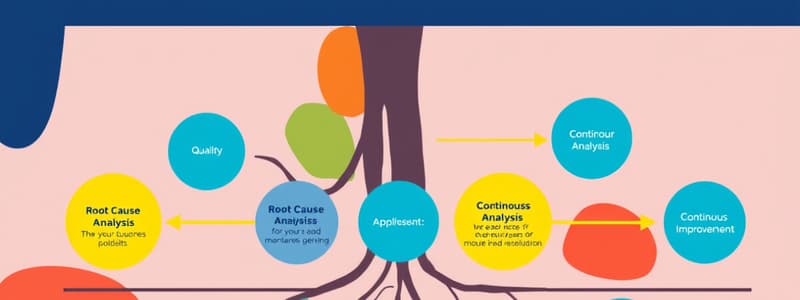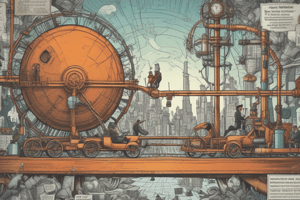Podcast
Questions and Answers
What is NOT one of the 7 Quality Tools?
What is NOT one of the 7 Quality Tools?
- Flow Chart
- Budget Chart (correct)
- Pareto Chart
- Control Chart
The '7 Habits of Excellence' includes 'Seek to be understood first, then to understand.'
The '7 Habits of Excellence' includes 'Seek to be understood first, then to understand.'
False (B)
Poor time management leads to ______.
Poor time management leads to ______.
stress
What diagram is also known as the Ishikawa Diagram?
What diagram is also known as the Ishikawa Diagram?
Match the symptoms of stress with their descriptions:
Match the symptoms of stress with their descriptions:
Which of the following is NOT considered a time waster?
Which of the following is NOT considered a time waster?
The 'Fight or Flight' response is a mental reaction to stress.
The 'Fight or Flight' response is a mental reaction to stress.
What are the five key components of SMART goals?
What are the five key components of SMART goals?
What is a key factor in managing work attitudes effectively?
What is a key factor in managing work attitudes effectively?
The term 'attitude' refers to one's action or reaction under specified circumstances.
The term 'attitude' refers to one's action or reaction under specified circumstances.
Name one negative virus that can be spotted in workplace attitudes.
Name one negative virus that can be spotted in workplace attitudes.
Body stress results from ______ and neglect.
Body stress results from ______ and neglect.
Which of the following is NOT one of the 'Agesless Problems' linked to negative attitudes?
Which of the following is NOT one of the 'Agesless Problems' linked to negative attitudes?
Match the type of negative virus with their characteristics:
Match the type of negative virus with their characteristics:
What is one suggested method to manage negative attitudes?
What is one suggested method to manage negative attitudes?
Environmental factors play no role in the development of negative attitudes.
Environmental factors play no role in the development of negative attitudes.
Flashcards
Root Cause Analysis (RCA)
Root Cause Analysis (RCA)
Identifying the fundamental reasons for a problem.
The '5 Why's' Technique
The '5 Why's' Technique
A method of repeatedly asking 'why' to uncover the root cause of a problem.
Cause and Effect Diagram
Cause and Effect Diagram
Diagram that visually shows the relationship between causes and effects.
SMART Goals
SMART Goals
Signup and view all the flashcards
Fishbone Diagram
Fishbone Diagram
Signup and view all the flashcards
Control Chart
Control Chart
Signup and view all the flashcards
Pareto Chart
Pareto Chart
Signup and view all the flashcards
Be Proactive
Be Proactive
Signup and view all the flashcards
Begin with the End in Mind
Begin with the End in Mind
Signup and view all the flashcards
Stress
Stress
Signup and view all the flashcards
Fight or Flight Response
Fight or Flight Response
Signup and view all the flashcards
Situational Stress
Situational Stress
Signup and view all the flashcards
Body Stress
Body Stress
Signup and view all the flashcards
Mind Stress
Mind Stress
Signup and view all the flashcards
Attitude
Attitude
Signup and view all the flashcards
Behavior
Behavior
Signup and view all the flashcards
Study Notes
RCI / RCA (Root Cause Identification / Root Cause Analysis)
- Root Cause Analysis aims to identify the underlying reasons for a problem.
- Methods include the 5 Why's technique, which involves asking "why" multiple times until the root cause is uncovered.
- Cause and Effect Diagram visually represents the relationship between causes and their effects.
SMART Goals
- Goals should be Specific, Measurable, Attainable, Relevant, and Time-bound.
Fish Bone Diagram
- Also known as the Ishikawa Diagram, it is used to analyze the causes of specific problems in detail.
7 Quality Tools
- Control Chart: Monitors process variations over time.
- Histogram: Displays the frequency distribution of data.
- Pareto Chart: Prioritizes problems based on their impact (80/20 rule).
- Scatter Diagram: Shows relationships between two variables.
- Check Sheet: Simple data collection tool.
- Cause and Effect Diagram: See above.
- Flow Chart: Visual representation of a process.
7 Habits of Excellence
- Be Proactive: Take initiative in life's situations.
- Begin with an END in Mind: Set clear objectives.
- Put First Things First: Prioritize tasks effectively.
- Think Win-Win: Seek mutual benefit in interactions.
- Seek First to Understand, Then to Be Understood: Listen actively to others.
- Synergize: Collaborate for better results.
- Sharpen the Saw: Continuously improve yourself.
Time and Stress Management
-
Common Symptoms of Stress:
- Irritability, Fatigue, Difficulty Concentrating, Forgetfulness, Loss of Sleep, Physical Disorders, Depression.
-
Time Management:
- Involves planning and scheduling to improve personal and corporate efficiency.
- Identifies Time Wasters such as interruptions, feelings of hopelessness, and poor delegation skills.
-
Main Secrets to Time Management:
- Setting clear goals, prioritizing tasks, effective scheduling, and rewarding achievements.
-
Understanding Stress:
- Stress is a bodily response to perceived danger, affecting mental, physical, emotional, and behavioral aspects.
Fight or Flight Response
- Body's automatic reaction to perceived threats, prompting rapid protective measures.
Causes of Workplace Stress
- Major contributors include uncertainty about goals, excessive workload, job dissatisfaction, conflicting demands, inadequate resources, and lack of appreciation.
Types of Stress
- Situational Stress: Directly caused by the environment.
- Body Stress: Physical symptoms from neglect or abuse.
- Mind Stress: Psychological impact of negative perceptions.
Managing Work Attitudes
- Understand both self and others to manage effectively.
- Individual differences influence behavior and attitudes.
The Ageless Problem
- Chronic tardiness, absenteeism, low output quality, poor relations, frequent policy violations, and resistance to change are common issues in workplaces.
Attitude vs. Behavior
- Attitude: Mental disposition towards an object or situation.
- Behavior: Observable actions in response to specific circumstances.
Types of Negative Attitudes
- Locomotive: Uses bullying to get results.
- Cry Baby: Displays negative emotions for sympathy.
- Resister: Defends the status quo.
- Criticizer: Always finds fault in others.
- Perfectionist: Sets unrealistic standards.
- Rumor Monger: Spreads gossip and negativity.
- Sacrificer: Overcommits time and energy.
- EscapeGoater: Blames others for failures.
- Pessimist: Focuses on drawbacks.
- Not-My-Jobber: Unwilling to extend beyond job roles.
- Mega-NEGA COMBO: Exhibits multiple negative traits simultaneously.
Reasons for Negative Attitudes
- Influenced by heredity, environmental factors, and individual experiences.
8 Ball Challenge for Positive Attitudes
- Recognize triggers, practice time-outs, set deadlines for negativity, embrace humor, express feelings, surround self with positivity, help others, and engage in self-care.
Studying That Suits You
Use AI to generate personalized quizzes and flashcards to suit your learning preferences.




